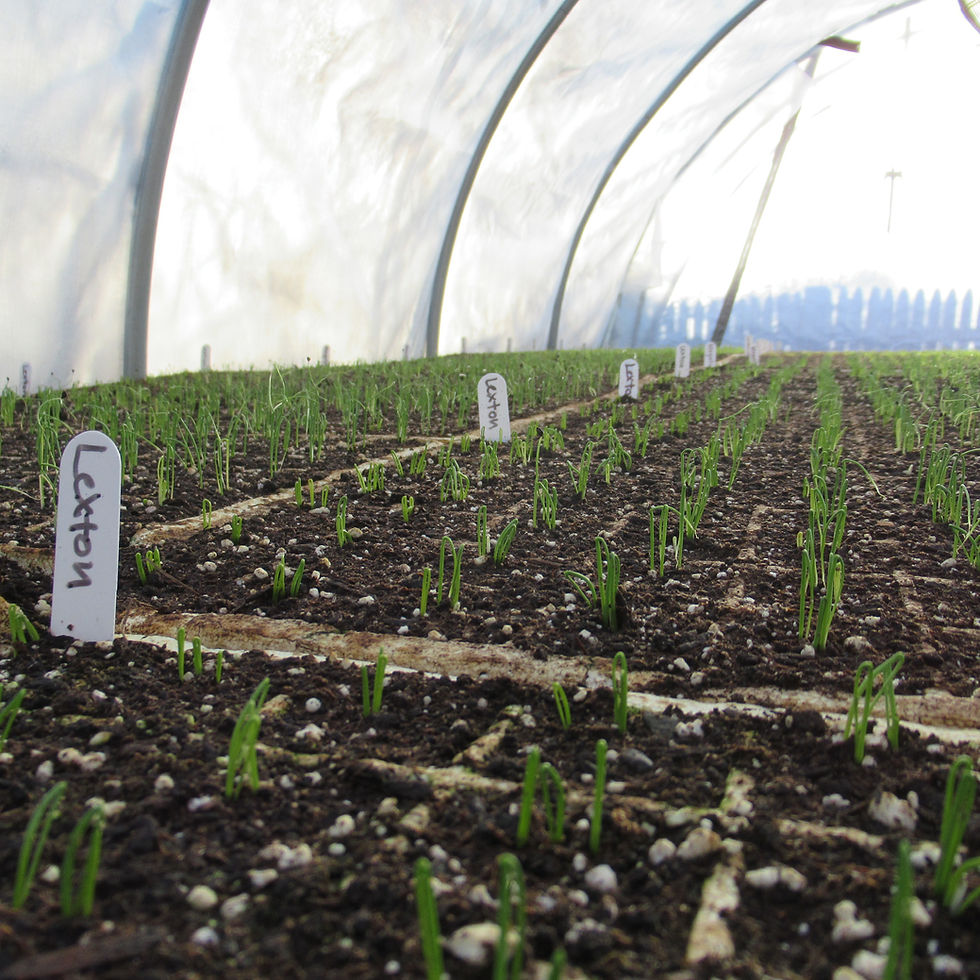Holding Pattern
- Caroline Fanning
- Mar 18, 2018
- 3 min read
So much for an early spring. February teased us with a week’s worth of balmy weather, but March has us bundled up in wool socks and long underwear. With the soil so cold and wet, there’s not much work to be done in the fields. There are, however, ample opportunities to walk and observe—where the snow is fastest to melt, where the cover crops are starting to come in, where the garlic is furthest along. We’re effectively in a holding pattern, but we also know that spring could break at any moment. When it does, we’ll be off and running.

The greenhouses at our home in Amityville are almost full. Flats of onions, leeks, and scallions are lined up like soldiers. The kale and chard are just starting to pop, and the beets, flowers, and parsley will germinate any day now. By the time we seed the spinach, the home greenhouses will be bursting at the seams. That’s when we’ll transfer the onions to the farm greenhouses, where they’ll harden off before going out into the fields.
At the farm, we’ve got sheds popping up like mushrooms. This is the result of being caught flat-footed last summer, when we lost use of the Old Bethpage Village barns for storage. Without adequate shelter for our equipment, supplies, and onion crop, we shifted items repeatedly, often losing time and straining our backs. Over the winter, however, we installed two sheds in the fields and reorganized the sheds at the Tin House. The goal is to store everything as close to where it will be needed as possible. Obvious perhaps, but easier said than done. Like any busy person, we’re liable to place things where they’re convenient in the short-term but illogical in the long-term. Making an extra trip out of the fields for drip tube may not be a big deal the first few times, but multiply it by a factor of ten, and, well, you get the point. Having once read that motion is one of the greatest wastes on any farm, I welcomed this rare opportunity to clean house and set things in order. Make no mistake, getting booted from the barns was very stressful at the time, but I now believe it was a blessing in disguise.
On the office end of things, we’re back to where we were a year ago, hustling to sell this season’s remaining CSA shares. I definitely miss the good old days of long waitlists and supply-demand ratios weighted in my favor, but I’m also resigned to the fact that marketing is now just part of the job. Among CSA farmers, there’s a lot of talk about how to stay competitive in the age of Amazon and Blue Apron, where convenience is king. In the end, however, we always come back to the same principle that birthed the CSA movement—that having a connection with local farms and farmers is something worth paying for, worth leaving the house for. At a time when virtually anything can be delivered to your doorstep, you’ve got to question what’s lost when you no longer have a reason, however mundane, to leave the house. Dan and I have always worked to provide an experience that equaled the food, and I believe that experience is all the more important now. A busy person can enter the Tin House and execute a vegetable pickup in less than five minutes, but the reality is that most members linger, sometimes for hours. Whether it’s to pick herbs, glean spinach, or chat with fellow members, there are many reasons to stay and hang out. Amazon can deliver many products, but it can’t deliver an experience, and that’s where CSA farms keep the advantage.


Meanwhile, the soil is still cold. Local garden gurus advise that you plant peas on St. Patrick’s Day, but I think their soil is sandier than mine. So we’ll be planting our peas along with the carrots in early April, weather permitting. In the meantime, we’ll continue cleaning up around the Tin House and chipping away at indoor projects while we wait for March to transform into the proverbial lamb.





















Comments